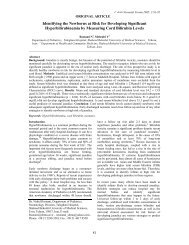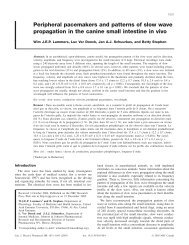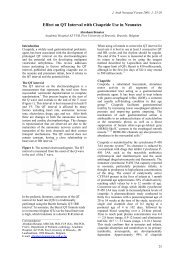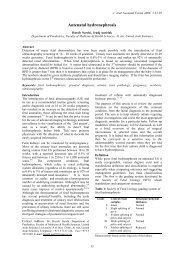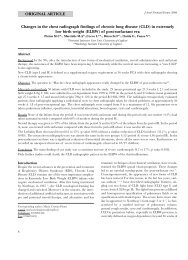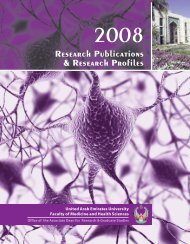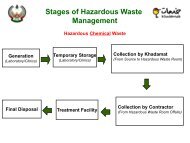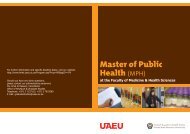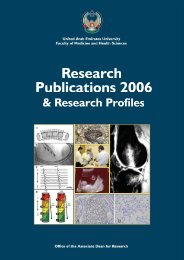Research Publications - College of Medicine and Health Science
Research Publications - College of Medicine and Health Science
Research Publications - College of Medicine and Health Science
You also want an ePaper? Increase the reach of your titles
YUMPU automatically turns print PDFs into web optimized ePapers that Google loves.
Department <strong>of</strong> Microbiology & Immunology<br />
46<br />
���������� The research in Dr Khan’s laboratory<br />
is focused on viral tumour biology. Viruses are<br />
now believed to be involved, directly or indirectly,<br />
in the pathogenesis <strong>of</strong> approximately 15% <strong>of</strong><br />
all human malignancies, accounting for around<br />
1.5 million cases worldwide. Most <strong>of</strong> these cases<br />
are due to just 6 viruses: HTLV-1, HPV, Hepatitis<br />
B <strong>and</strong> C, HHV-8 <strong>and</strong> EBV. We are interest in<br />
underst<strong>and</strong>ing the mechanisms by which some<br />
<strong>of</strong> these viruses, in particular EBV, lead to cell<br />
transformation <strong>and</strong> proliferation. EBV is arguably<br />
one <strong>of</strong> the best studied human oncogenic<br />
viruses implicated in the pathogenesis <strong>of</strong> a<br />
number <strong>of</strong> malignancies <strong>of</strong> both epithelial <strong>and</strong><br />
lymphoid origin. We are trying to underst<strong>and</strong><br />
the role <strong>of</strong> some <strong>of</strong> the viral latent products in<br />
regulating latency, inhibition <strong>of</strong> apoptosis <strong>and</strong><br />
cell proliferation.<br />
<strong>Research</strong> Highlight: Although numerous studies<br />
have been published over the last 10 to<br />
���������������� My main research interest is the<br />
investigations <strong>of</strong> the molecular epidemiology <strong>of</strong><br />
multi drug resistant Gram negative pathogens<br />
<strong>and</strong> <strong>of</strong> the genetic background <strong>of</strong> their antibiotic<br />
resistance. We are focusing particularly on<br />
the strains producing carbapenemases, i.e. an<br />
emerging threat in the UAE. Also, the relationship<br />
between drug resistance <strong>and</strong> the presence<br />
<strong>of</strong> certain virulence genes <strong>and</strong> cell wall elements<br />
are being studied. We cooperate with colleagues<br />
in Paris, Edinburgh, Vienna.<br />
15 years looking at the possible link between<br />
EBV <strong>and</strong> the pathogenesis <strong>of</strong> breast cancer, the<br />
association remains controversial <strong>and</strong> reports<br />
from both corners <strong>of</strong> the arena continue to be<br />
published. We too have examined the potential<br />
association <strong>of</strong> EBV to the pathogenesis <strong>of</strong> breast<br />
cancer in a large series <strong>of</strong> cases using a highly<br />
sensitive in situ hybridization method capable<br />
<strong>of</strong> detecting as little as a few EBV infected<br />
cells in an entire tissue section. We found that,<br />
although EBV can be detected in approximately<br />
50% <strong>of</strong> breast cancer cases, the virus<br />
is not present in the malignant cells. Rather,<br />
the virus is localized to occasional infiltrating<br />
lymphocytes (Fig. 3), which could give rise to<br />
‘false’ interpretations <strong>of</strong> PCR-based studies linking<br />
the virus to the pathogenesis <strong>of</strong> the disease.<br />
Furthermore, we did not find any correlation<br />
between the presence <strong>of</strong> EBV in infiltrating<br />
lymphocytes <strong>and</strong> ER, PR, HER2 expression or<br />
metastasis status.<br />
� �<br />
Figure 3<br />
Detection <strong>of</strong> EBV by EBER-in situ hybridization (EBER-ISH) in breast tissues. EBER-ISH showing positive signal (brown staining) in<br />
an occasional infiltrating lymphocyte (arrow) in: (a) Reactive non-malignant breast tissues (b) Invasive ductal carcinoma <strong>of</strong> the<br />
breast. No positive signal for EBV was seen in the malignant cells in any <strong>of</strong> the 61 cases examined, indicating that EBV is not directly<br />
involved in the pathogenesis <strong>of</strong> this malignancy (from Khan et al. Exp Mol Pathol. 2011;91:466-70).<br />
���������������������Dr. Rizvi has been interested<br />
in studying the basic steps in retroviral<br />
replication for nearly two decades now. He<br />
started his independent investigations with how<br />
retroviruses regulate the expression <strong>of</strong> their<br />
gene products. While continuing this work, the<br />
current research in his laboratory is now focused<br />
on how retroviruses/lentiviruses dimerize <strong>and</strong><br />
package their genomic RNAs into a virus particle<br />
<strong>and</strong> what are some <strong>of</strong> the underlying molecular<br />
intricacies during these crucial steps in retroviral




